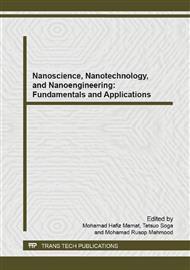[1]
A. Rasooly, "Biosensor technologies," Editor. / Methods, vol. 37, no. 1, p.1–3, Sep. 2005.
Google Scholar
[2]
P. T. Kissinger, "Biosensors - A Perspective," Biosens. Bioelectron., vol. 20, no. 12, p.2512–6, Jun. 2005.
Google Scholar
[3]
R. Monošík, M. Streďanský, and E. Šturdík, "Biosensors - Classification, Characterization and New Trends," Acta Chim. Slovaca, vol. 5, no. 1, p.109–120, Jan. 2012.
DOI: 10.2478/v10188-012-0017-z
Google Scholar
[4]
C. Jianrong, M. Yuqing, H. Nongyue, and W. Xiaohua, "Nanotechnology and biosensors," vol. 22, p.505–518, 2004.
DOI: 10.1016/j.biotechadv.2004.03.004
Google Scholar
[5]
Y.-F. Liang, C.-Y. Huang, and B.-D. Liu, "A Voltammetry Potentiostat Design for Large Dynamic Range Current Measurement," Int. Conf. Intell. Comput. Bio-Medical Instrum., vol. 2, p.260–263, Dec. 2011.
DOI: 10.1109/icbmi.2011.44
Google Scholar
[6]
P. Kundu and R. Yadav, "Effect of High-K Dielectric Materials on Leakage Current," Int. J. Electron. Comput. Sci. Eng., vol. 1, no. 3, p.1454 –1458, 2009.
Google Scholar
[7]
X. Shi, W. Gu, B. Li, N. Chen, K. Zhao, and Y. Xian, "Enzymatic Biosensors Based on the Use of Metal Oxide Nanoparticles," Microchim. Acta, p.1–22, 2014.
DOI: 10.1007/s00604-013-1069-5
Google Scholar
[8]
S. Nadzirah and U. Hashim, "Annealing effects on titanium dioxide films by Sol-Gel spin coating method," RSM 2013 IEEE Reg. Symp. Micro Nanoelectron., p.159–162, Sep. 2013.
DOI: 10.1109/rsm.2013.6706497
Google Scholar
[9]
D. Kaczmarek, J. Domaradzki, D. Wojcieszak, and B. Gornicka, "XRD and AFM Studies of Nanocrystalline TiO2 Thin Films Prepared by Modified Magnetron Sputtering," Int. Spring Semin. Electron. Technol., p.159–162, May 2008.
DOI: 10.1109/isse.2008.5276518
Google Scholar
[10]
D. Yoo, I. Kim, S. Kim, C. H. Hahn, C. Lee, and S. Cho, "Effects of annealing temperature and method on structural and optical properties of TiO2 films prepared by RF magnetron sputtering at room temperature," Appl. Surf. Sci., vol. 253, no. 8, p.3888–3892, Feb. 2007.
DOI: 10.1016/j.apsusc.2006.08.019
Google Scholar
[11]
T. K. Gupta, "Dielectric Materials," in Copper Interconnect Technology, New York, NY: Springer New York, 2009, p.67–110.
Google Scholar
[12]
"Process Integration, Devices, and Structure," 2011.
Google Scholar
[13]
H. Wong, "The current conduction issues in high-k gate dielectrics," Electron Devices and Solid-State Circuits, no. CityU 121707, p.31–36, 2007.
DOI: 10.1109/edssc.2007.4450055
Google Scholar
[14]
M. Ahmadi, "Study of Different Parameters in TiO2 Nanoparticles Formation," J. Mater. Sci. Eng., vol. 5, p.87–93, 2011.
Google Scholar
[15]
L. Huang, A. L. Porter, and Y. Guo, "Identifiying Emerging Nanoparticle Roles in Biosensors," Int. Assoc. Manag. Technol., 2008.
Google Scholar
[16]
S. M. Gupta and M. Tripathi, "A Review of TiO2 Nanoparticles," Chinese Sci. Bull., vol. 56, no. 16, p.1639–1657, May 2011.
DOI: 10.1007/s11434-011-4476-1
Google Scholar
[17]
H. Shi, R. Magaye, V. Castranova, and J. Zhao, "Titanium Dioxide Nanoparticles: A Review of Current Toxicological Data," Part. Fibre Toxicol., vol. 10, p.15, Jan. 2013.
DOI: 10.1186/1743-8977-10-15
Google Scholar
[18]
R. H. Prasad, U. Hashim, K. L. Foo, T. Adam, and M. Shafiq, "Study the Optical Characteristic of ZnO Nanostructure through Annealing at Various Time Period," Adv. Mater. Res., vol. 832, p.68–72, Nov. 2013.
DOI: 10.4028/www.scientific.net/amr.832.68
Google Scholar
[19]
R. H. Prasad, U. Hashim, K. L. Foo, and M. Shafiq, "Investigating the annealing effect on the conventional growth of ZnO nanorod through electrical characterization," RSM 2013 IEEE Reg. Symp. Micro Nanoelectron., p.304–307, Sep. 2013.
DOI: 10.1109/rsm.2013.6706536
Google Scholar
[20]
A. Santos, T. Kumeria, and D. Losic, "Nanoporous anodic aluminum oxide for chemical sensing and biosensors," Trends Anal. Chem., vol. 44, p.25–38, Mar. 2013.
DOI: 10.1016/j.trac.2012.11.007
Google Scholar
[21]
B. Malhotra and A. Kaushik, "Metal oxide–chitosan based nanocomposite for cholesterol biosensor," Thin Solid Films, 2009.
DOI: 10.1016/j.tsf.2009.07.036
Google Scholar
[22]
S. Saha, S. K. Arya, S. P. Singh, K. Sreenivas, B. D. Malhotra, and V. Gupta, "Nanoporous cerium oxide thin film for glucose biosensor.," Biosens. Bioelectron., vol. 24, no. 7, p.2040–5, Mar. 2009.
DOI: 10.1016/j.bios.2008.10.032
Google Scholar
[23]
M. M. Rahman, a J. S. Ahammad, J.-H. Jin, S. J. Ahn, and J.-J. Lee, "A comprehensive review of glucose biosensors based on nanostructured metal-oxides.," Sensors, vol. 10, no. 5, p.4855–86, Jan. 2010.
DOI: 10.3390/s100504855
Google Scholar
[24]
A. A. Ansari, A. Kaushik, P. R. Solanki, and B. D. Malhotra, "Sol–gel Derived Nanoporous Cerium Oxide Film for Application to Cholesterol Biosensor," Electrochem. commun., vol. 10, no. 9, p.1246–1249, Sep. 2008.
DOI: 10.1016/j.elecom.2008.06.003
Google Scholar
[25]
X. Xiao, Q. Luan, X. Yao, and K. Zhou, "Single-crystal CeO2 nanocubes used for the direct electron transfer and electrocatalysis of horseradish peroxidase.," Biosens. Bioelectron., vol. 24, no. 8, p.2447–51, Apr. 2009.
DOI: 10.1016/j.bios.2008.12.020
Google Scholar
[26]
M. Lee, N. Zine, A. Baraket, M. Zabala, F. Campabadal, R. Caruso, M. G. Trivella, N. Jaffrezic-Renault, and A. Errachid, "A Novel Biosensor Based on Hafnium Oxide: Application for Early Stage Detection of Human Interleukin-10," Sensors Actuators B Chem., vol. 175, p.201–207, Dec. 2012.
DOI: 10.1016/j.snb.2012.04.090
Google Scholar
[27]
P. R. Solanki, A. Kaushik, V. V. Agrawal, and B. D. Malhotra, "Nanostructured metal oxide-based biosensors," NPG Asia Mater., vol. 3, no. 1, p.17–24, Jan. 2011.
DOI: 10.1038/asiamat.2010.137
Google Scholar


